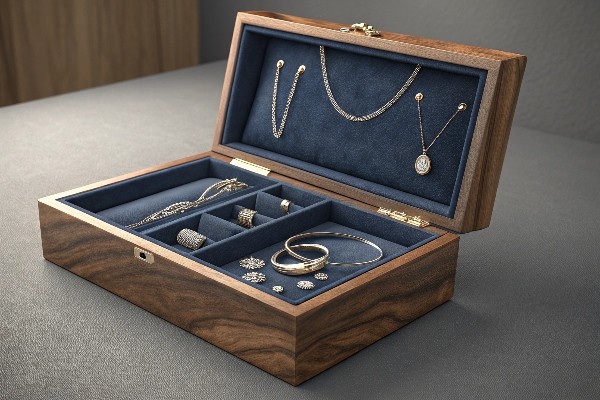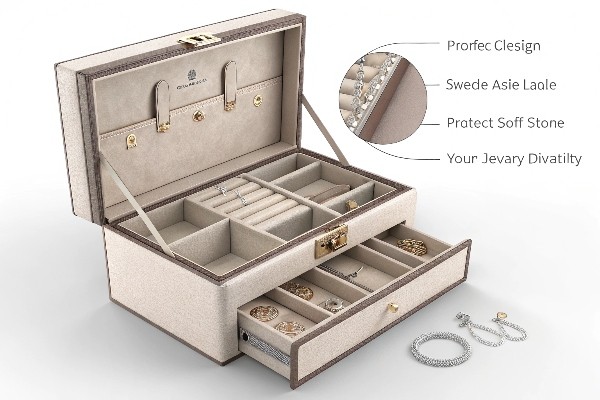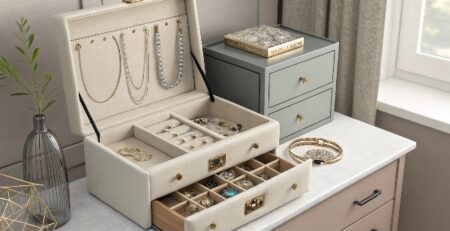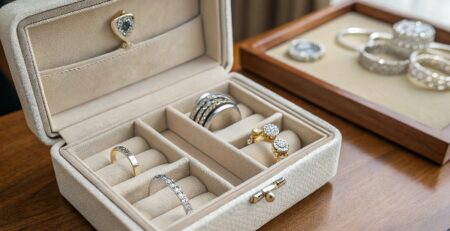What is the Best Material for the Inside of a Jewelry Box?
leading paragraph:
You have nice jewelry. You need a good place to keep it safe. What is the best material for the inside?
snippet paragraph:
The best materials for the inside of a jewelry box are soft ones. Think velvet, silk, or felt. These materials protect jewelry from scratches. They also keep items from moving around inside the box. The right lining keeps your treasures safe.
Transition Paragraph:
Choosing the right material for the inside of your jewelry box matters a lot. It is not just about looks. It is about keeping your valuable items protected. But the inside is only part of the story. The box itself needs to be made well. Let's look closer at all the parts that make a jewelry box good.
What is the best material for jewelry boxes?
leading paragraph:
You want a nice jewelry box. You need to know what materials are best. What makes a jewelry box good?
snippet paragraph:
The best jewelry boxes use good materials for the structure and the inside. Strong materials like wood or rigid cardboard are used for the outside. Soft materials like velvet or silk are used for the lining. These materials work together to make a safe and beautiful box.
!
Dive deeper Paragraph:
When you look at a really nice jewelry box, you see more than just the color or the shape. You feel the weight. You see how the corners meet. This tells you about the materials used for the box itself. A good jewelry box starts with a strong base. Often, this base is made from wood or thick, rigid cardboard. Rigid cardboard is very common for many types of deluxe packaging, like gift boxes or decorative boxes 1. It gives the box its strength and shape. I know that making these rigid boxes needs precision. Machines help a lot with this. For example, getting crisp corners is key. Some old ways of making boxes leave gaps at the corners, even after covering them 2. But using the right process, like grooving the cardboard, helps make perfectly square, strong corners 3. This strong frame is the first material that matters. After the frame is ready, the box is covered with nice paper, leatherette, or fabric on the outside. Then, the inside material goes in. The materials on the outside and inside must be put on smoothly. This needs good glue and careful work. The quality of the box structure is the foundation. If the structure is weak, the box will not protect your jewelry well, no matter how nice the lining is. Think of it like building a house. You need a strong foundation before you add nice floors or paint.
Tertiary Heading: Why Structure Matters
A rigid box structure provides:
| Benefit | Why It's Important |
|---|---|
| Strength | Protects contents from crushing. |
| Durability | Makes the box last a long time. |
| Good Shape Hold | Keeps compartments in place. |
| Supports Lining | Provides a smooth base for the liner. |
Machines I know, like those my company, Kylin Packaging Machinery, makes, build this strong base. They help create the precise cuts and folds needed for rigid boxes. This ensures the box has the right shape and strength before any lining is added. The quality of the box material and how it is put together is the first step to a good jewelry box.
What should a jewelry box be lined with?
leading paragraph:
You have a nice jewelry box. What kind of material should be on the inside? What is best for your jewelry?
snippet paragraph:
A jewelry box should be lined with a soft material. Materials like velvet, suede, silk, or felt are common choices. These linings protect jewelry from scratches and dust. They create a gentle surface for rings, necklaces, and earrings.

Dive deeper Paragraph:
Picking the inside material is very important for a jewelry box. The lining is what touches your jewelry directly. Its main job is to protect each piece. Jewelry can be delicate. Metals can scratch. Stones can be damaged. The right lining material prevents this from happening. The lining also helps keep items from tangling, especially necklaces. When I see a new jewelry box being made, I always check the lining. Is it soft? Is it put in smoothly? There are several types of materials people use for the inside. Velvet is a popular choice. It is very soft and has a nice feel. It looks luxurious. Suede is another good option. It is also soft and has a different texture than velvet. Silk and satin are used too, especially in more expensive boxes. They look very elegant and smooth. Felt is a simpler, often less expensive option. It provides good protection, but it might not look as fancy as velvet or silk. Each material has its own feel and look. When I see a beautiful box, I know the lining was chosen with care. It shows the box was made to protect something valuable. The material needs to be attached well to the inside of the rigid box structure. Good glue is needed here. The glue must hold the lining in place without showing through or causing problems like bubbles 4. The smooth, strong inside surface of a rigid box is perfect for applying these soft linings. This is another way the quality of the box structure affects the final product.
Tertiary Heading: Common Lining Materials Compared
| Material | Feel | Look | Protection Level | Cost (Generally) |
|---|---|---|---|---|
| Velvet | Very Soft | Rich, Plush | High | Medium to High |
| Suede | Soft | Matte | High | Medium to High |
| Silk | Smooth | Shiny | Medium to High | High |
| Satin | Smooth | Shiny | Medium | Medium |
| Felt | Soft/Slightly Rough | Matte | Good | Low |
The best choice depends on what kind of jewelry goes inside and the overall style of the box. No matter the material, it must be attached well to the inside walls and compartments. A good lining makes the box functional and beautiful.
What is the best fabric to line a jewelry box?
leading paragraph:
You want a fabric lining for your jewelry box. Which fabric is the best choice? There are many options.
snippet paragraph:
The best fabrics for lining a jewelry box are soft and non-abrasive. Velvet is often seen as the top choice because it is very soft and helps prevent tangling. Silk and satin are also good, offering a smooth, elegant surface for jewelry.

Dive deeper Paragraph:
Focusing just on fabrics, velvet is often the material people think of first for a high-quality jewelry box lining. Why velvet? It has a thick, soft pile. This pile creates a cushion for the jewelry. It stops items from rubbing against each other. This means fewer scratches. Velvet also helps keep necklaces from tangling as easily. The soft fibers provide a gentle barrier. Silk is another excellent fabric choice. It feels incredibly smooth and looks luxurious. Silk lining is often found in very high-end jewelry boxes. It does not offer the same cushioning as velvet, but it is very soft and will not scratch jewelry. Satin is similar to silk in looks, it is smooth and shiny. It is often used because it can be less expensive than real silk. However, satin might not be quite as durable or as smooth as silk over time. When I talk to people who make packaging, they care a lot about how the fabric looks and feels inside the box. They need fabric that is easy to work with and looks perfect once it is in place. The fabric needs to be cut precisely and glued down smoothly. The quality of the rigid box structure is important here again. A smooth, flat inside surface is needed for the fabric to lie flat and look good. If the cardboard underneath is uneven or the corners are messy, the fabric lining will not look right. It will show the imperfections. Machines that make rigid boxes help create this smooth base. This is why the manufacturing process for the box structure is key to the final quality of the lined box. Getting the fabric attached smoothly is the last step in making the inside of the box beautiful and protective.
Tertiary Heading: Fabric Lining Options
| Fabric | Key Feature | Softness | Appearance | Best For |
|---|---|---|---|---|
| Velvet | Soft Pile, Cushion | Very High | Rich, Plush | Preventing scratches and tangling |
| Silk | Very Smooth, Natural | Very High | Elegant, Shiny | High-end boxes, delicate items |
| Satin | Smooth, Synthetic | High | Shiny | Elegant look at a lower cost |
| Felt | Dense, Simple | Medium | Matte, Basic | Basic protection, less expensive boxes |
Choosing the fabric is a balance of protection, look, and cost. Each fabric offers different benefits. The best one depends on the jewelry and the desired feel of the box.
What should I look for in a jewelry box?
leading paragraph:
You are looking for a new jewelry box. There are many types. What are the most important things to check for?
snippet paragraph:
When buying a jewelry box, look for good structure, a soft lining, and smart organization. The box should be sturdy and well-made. The inside material must protect your jewelry. It should have compartments that fit your specific items.

Dive deeper Paragraph:
Looking for a jewelry box means checking several things. First, feel the box itself. Does it feel strong? Or does it feel flimsy? A good jewelry box has a solid structure. Rigid boxes are often the best kind for this because they are made from thick board. They hold their shape well. You should look at the corners and edges. Are they neat and tight? Or are they uneven? This tells you about how well the box was made. Machines play a big role in making these structures precise. For example, my company makes machines that are good at making rigid boxes 5. They help get those clean lines and strong joins. After checking the outside structure, look at the inside. Is the lining material soft? Does it cover all the inside surfaces smoothly? Run your hand over it. Make sure there are no loose spots or wrinkles. Check that the lining is attached well. It should not lift up easily. Next, look at the organization inside. Does it have slots for rings? Hooks for necklaces? Divided areas for earrings or bracelets? The layout should match the type of jewelry you own. A good box has compartments that fit your needs. Also, check the lid. Does it close securely? Does it have a good hinge? Sometimes, jewelry boxes have special features like trays that lift out or secret compartments. Think about the size of the box. Is it big enough for your current jewelry? Will it have space for new pieces? The overall quality of the box, from its rigid structure to its soft lining and smart layout, is what makes it a good place for your jewelry. Making all these parts come together well takes skill and good machinery.
Tertiary Heading: Key Features of a Good Jewelry Box
| Feature | What to Check For | Why It Matters |
|---|---|---|
| Strong Structure | Made from thick board (rigid box), neat corners. | Protects from damage, lasts longer. |
| Soft Lining | Velvet, silk, felt; smooth, well-attached. | Prevents scratches and tangling. |
| Good Organization | Ring slots, necklace hooks, divided areas. | Keeps jewelry tidy and easy to find. |
| Secure Closure | Lid fits well, strong hinge. | Keeps dust out, contents safe. |
| Quality Craftsmanship | No visible glue, neat covering, sturdy parts. | Shows attention to detail, means the box will last. |
A good jewelry box is an investment in protecting your valuable items. Pay attention to these details when you choose one.
Conclusion
Picking the right lining for a jewelry box protects your treasures. Soft fabrics like velvet or silk are best. But remember, the box's strong structure is also key.
-
Source material mentions Gift boxes, Rigid boxes, Decoratiove boxes. ↩
-
Source material compares stay machine vs groove machine, mentioning recesses in corners with stay machine. ↩
-
Source material discusses using a groove machine to make rigid boxes with 90 degree folded lines. ↩
-
Source material discusses jelly glue properties, like avoiding bubble and distortion. ↩
-
Source material lists Kylin machines used for making rigid boxes (stay machine, Paper boxes press machine).








发表回复